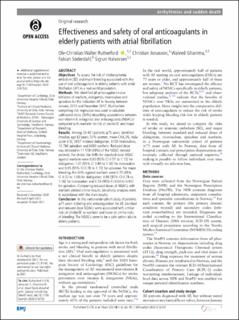| dc.contributor.author | Rutherford, Ole-Christian Walter | |
| dc.contributor.author | Jonasson, Christian | |
| dc.contributor.author | Ghanima, Waleed | |
| dc.contributor.author | Söderdahl, Fabian | |
| dc.contributor.author | Halvorsen, Sigrun | |
| dc.date.accessioned | 2022-02-07T12:43:47Z | |
| dc.date.available | 2022-02-07T12:43:47Z | |
| dc.date.created | 2021-06-14T23:03:25Z | |
| dc.date.issued | 2021 | |
| dc.identifier.citation | Heart. 2021, 1-8. | en_US |
| dc.identifier.issn | 1355-6037 | |
| dc.identifier.uri | https://hdl.handle.net/11250/2977494 | |
| dc.description.abstract | Objectives To assess the risk of stroke/systemic embolism (SE) and major bleeding associated with the use of oral anticoagulants in elderly patients with atrial fibrillation (AF) in a real-world population.
Methods We identified all anticoagulant-naive initiators of warfarin, dabigatran, rivaroxaban and apixaban for the indication AF in Norway between January 2013 and December 2017. Multivariate competing risk regression was used to calculate subhazard ratios (SHRs) describing associations between non-vitamin K antagonist oral anticoagulants (NOACs) compared with warfarin for risk of stroke/SE and major bleeding.
Results Among 30 401 patients ≥75 years identified (median age 82 years, 53% women, mean CHA2DS2-VaSc score 4.5), 3857 initiated dabigatran, 6108 rivaroxaban, 13 786 apixaban and 6650 warfarin. Reduced dose was initiated in 11 559 (49%) of the NOAC-treated patients. For stroke, the SHRs for standard dose NOAC against warfarin were 0.80 (95% CI 0.57 to 1.13) for dabigatran; 1.07 (95% CI 0.89 to 1.30) for rivaroxaban and 0.95 (95% CI 0.78 to 1.15) for apixaban. For major bleeding, the SHRs against warfarin were 0.75 (95% CI 0.52 to 1.08) for dabigatran; 0.96 (95% CI 0.78 to 1.16) for rivaroxaban and 0.74 (95% CI 0.60 to 0.91) for apixaban. Comparing reduced doses of NOACs with warfarin yielded similar results. Sensitivity analyses were in accordance with the main results.
Conclusion In this nationwide cohort study of patients ≥75 years initiating oral anticoagulation for AF, standard and reduced dose NOACs were associated with similar risks of stroke/SE as warfarin and lower or similar risks of bleeding. The NOACs seem to be a safe option also in elderly patients. | en_US |
| dc.language.iso | eng | en_US |
| dc.publisher | BMJ Publishing Group Ltd. | en_US |
| dc.rights | Navngivelse-Ikkekommersiell 4.0 Internasjonal | * |
| dc.rights.uri | http://creativecommons.org/licenses/by-nc/4.0/deed.no | * |
| dc.title | Effectiveness and safety of oral anticoagulants in elderly patients with atrial fibrillation | en_US |
| dc.type | Peer reviewed | en_US |
| dc.type | Journal article | en_US |
| dc.description.version | publishedVersion | en_US |
| dc.rights.holder | © Author(s) (or their employer(s)) | en_US |
| dc.source.pagenumber | 1-8 | en_US |
| dc.source.journal | Heart | en_US |
| dc.identifier.doi | 10.1136/heartjnl-2020-318753 | |
| dc.identifier.cristin | 1915764 | |
| cristin.ispublished | true | |
| cristin.fulltext | original | |
| cristin.qualitycode | 1 | |

